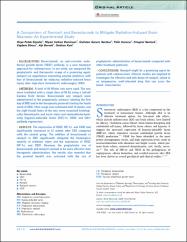A Comparison of Ramipril and Bevacizumab to Mitigate Radiation-Induced Brain Necrosis: An Experimental Study

View/
Access
info:eu-repo/semantics/openAccessDate
2020Author
Erpolat, Özge PetekDemircan, Niyazi Volkan
Sarıbaş, Gülistan Sanem
Kuzucu, Pelin
Senturk, Ertugrul
Elmas, Çiğdem
Borcek, Alp
Kurt, Gökhan
Metadata
Show full item recordCitation
Erpolat, O. P., Demircan, N. V., Sarıbas, G. S., Kuzucu, P., Senturk, E., Elmas, C., ... & Kurt, G. (2020). A comparison of ramipril and bevacizumab to mitigate radiation-induced brain necrosis: an experimental study. World neurosurgery, 144, e210-e220.Abstract
Background: Bevacizumab, an anti-vascular endothelial growth factor (VEGF) antibody, is a new treatment approach for radionecrosis. In our study, we compared the prophylactic and therapeutic usage of a promising agent, ramipril (an angiotensin-converting enzyme inhibitor), with that of bevacizumab for reducing radiation-induced brain injury after high-dose stereotactic radiosurgery (SRS). Methods: A total of 60 Wistar rats were used. The rats were irradiated with a single dose of 50 Gy using a Leksell Gamma Knife device. Bevacizumab and ramipril were administered in the prophylactic protocol (starting the first day of SRS) and in the therapeutic protocol (starting the fourth week of SRS). Their usage was continued until 12 weeks, and the right frontal lobes of the rats were examined histologically (hematoxylin and eosin stain) and immunohistochemically (hypoxia-inducible factor [HIF]-1α, VEGF, and CD31 antibody expression). Results: The expression of VEGF, HIF-1α, and CD31 had significantly increased at 12 weeks after SRS compared with the control group. The addition of bevacizumab or ramipril to SRS significantly mitigated the histological severity of radiation injury and the expression of VEGF, HIF-1α, and CD31. However, the prophylactic use of bevacizumab and ramipril seemed to be more effective than therapeutic administration. Our results also revealed that the greatest benefit was achieved with the use of prophylactic administration of bevacizumab compared with other treatment protocols. Conclusions: Ramipril might be a promising agent for patients with radionecrosis. Clinical studies are required to investigate the effective and safe doses of ramipril, which is an inexpensive, well-tolerated drug that can cross the blood–brain barrier. © 2020 Elsevier Inc.

















